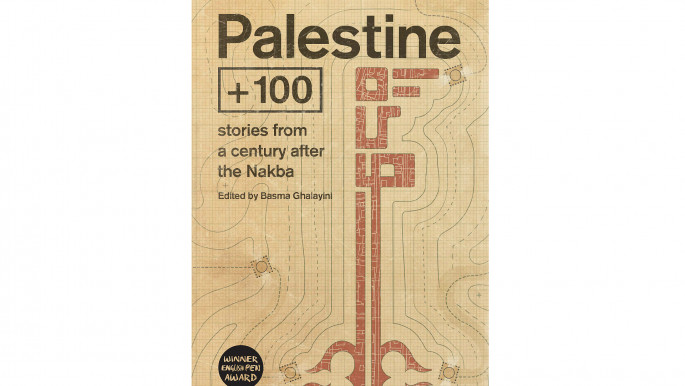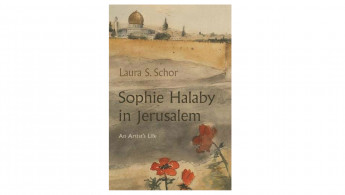Sophie Halaby in Jerusalem: An artist's historical trajectory of how Palestine was altered
"The political vicissitudes of her times – war, threat of war, and occupation – shaped her life. However she focused on the enduring beauty of the landscape and flowers of Jerusalem, not on the traumatic experiences of her life."
The introduction to Sophie Halaby in Jerusalem: An Artist's Life (Syracuse University Press), a biography of an important, but lesser known, Palestinian artist, succinctly sets the tone for the rest of the book, in which the author, Laura S. Schor, traces the artist's life through the ongoing colonisation and occupation of Palestine.
Built upon interviews to make up for the loss of Sophie's documents and photographs, the book follows a historical trajectory of how Palestine was altered in the artist's era.
It is through this detail that the reader can imagine Sophie's navigation of the circumstances, as well as her art. The gap as regards first-hand information is also in a way reflective of the artist's character, described as a solitary person who relished her privacy and who thought of her studio as a personal sanctuary.
Sophie Halaby was born either in Jerusalem on in Kiev – there is no evidence to support either possibility – to a Russian mother and a Palestinian father. She lived at a time of evolving Palestinian identity and politics, thus becoming influenced by geophysical change. The latter might have influenced her expression for nostalgia and the past, as Sophie's art journey took her not towards the Palestinian national movement and its artistic expression, but rather to affirm a connection with unadulterated land.
The Halaby family was affluent, thus Sophie was able to expand her horizons, including studying art in Paris when the 1929 revolts broke out. She also worked for the British Administration in Palestine prior to her travels, which gave her insight into the discriminatory practices employed by the British as regards pay scales for Palestinian workers.
 |
In her paintings, she quietly protested the presence of European architecture by eliminating the new buildings and the new roads that connected them from her landscapes of untouched hills |  |
 |
| Read more from The New Arab's Book Club: Palestine +100: Stories from a century after the Nakba |
The major part of the biography deals with the changing social and political realities in Palestine, as Jewish colonial settlers increased and the landscape altered to accommodate Israel.
The author, Laura Schor, speaks about the discrepancy in Sophie's art thus: "In her paintings, she quietly protested the presence of European architecture by eliminating the new buildings and the new roads that connected them from her landscapes of untouched hills."
Sophie's return to Jerusalem in 1933 was marked by Palestinian narratives and Zionist counter-narratives, which ultimately also influenced the art scene in Jerusalem.
Sophie's political cartoon contributions during the 1936-1939 Arab Revolts portray her opposition to the British and Zionism. Indeed, her cartoons criticise British policy in Palestine.
However, for the most part, Sophie's art strikes a solitary note and the author notes a difference between her experience of Palestine and those of exiled Palestinian artists.
"Exiled artists painted from memories and from stories of the homeland; for them, the homeland was an idea. Sophie was not part of this group; her homeland was all around her. Her art remained independent of the ideology and its attendant aesthetic that were created in the diaspora."
Sophie's experience of Jerusalem and indeed her own status coming from an elite family, influenced her artistic expression.
 |
Exiled artists painted from memories and from stories of the homeland; for them, the homeland was an idea. Sophie was not part of this group; her homeland was all around her. Her art remained independent of the ideology and its attendant aesthetic that were created in the diaspora |  |
She remained detached from political involvement, yet at age 61 she collaborated with her sister Asia, to save Jordanian soldiers from the Israeli military by hiding them in her house in Jerusalem.
As an artist, Sophie's attachment to Jerusalem prior to Zionist colonisation is evident. Her paintings mostly consist of wild flowers and hills, all reminiscent of Palestine before it was permanently altered. The architectural changes taking place did not manifest in Sophie's art.
She opted for an unadulterated remembrance of Palestine which, in itself, defined Israel and the changes it was making to the landscape to accommodate its settler population.
Read also: 'Deal of the Century': Palestinians feel letdown but can they resist American and Israeli dictation?
Schor writes, "Sophie's personal vision of Jerusalem imbued her studio. When she was certain that the painting was finished, she signed her name and sometimes added 'Jerusalem'."
In her letters, Sophie documented the changes to Jerusalem, yet she refused to join the Palestinian national movement's artists. Her art continued to stand as an expression on its own.
The author states, "Sophie continued to paint the hills surrounding Jerusalem as barren ridges. She removed from her canvas any expression of the new construction. This was her form of protest."
Her paintings, some of which are included in the book, portray a simplicity that cannot be overlooked. The nostalgia for the homeland – a theme common to Palestinians – is evident in Sophie's art. Besides being a testimony of Palestine prior to Zionist colonisation, her paintings also repudiate the fragmentation of land which Sophie details in her correspondence as "feverish activity to destroy as much as possible". In her art, however, Jerusalem and its surroundings remained untarnished.
While the limitations in researching this book are acknowledged by the author, at times Sophie's absence in a book about her life in Jerusalem was disconcerting. At the same time, the book reflects the artist's elusive nature.
Yet it is the author's reflection, towards the end of the book, which contextualises the artist's life and that of other Palestinians since the 1948 Nakba.
"Sophie's identity – that of a Palestinian, Russian Orthodox, and artist – forecasted the fragmented identity of Palestinians in the diaspora today." It is by returning to Sophie's artistic expression, that the image of unity is found to prevail.
Ramona Wadi is an independent researcher, freelance journalist, book reviewer and blogger specialising in the struggle for memory in Chile and Palestine, colonial violence and the manipulation of international law.
Follow her on Twitter: @walzerscent
The New Arab Book Club: Click on our Special Contents tab to read more book reviews and interviews with authors:




